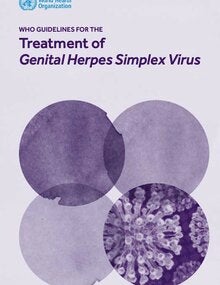Rationale for the guidelines
Since the publication of the World Health Organization (WHO) Guidelines for the management of sexually transmitted infections in 2003, changes in the epidemiology of STIs and advancements in prevention, diagnosis and treatment necessitate changes in STI management. These guidelines provide updated treatment recommendations for genital HSV infection based on the most recent evidence; they form one of several modules of guidelines for specific STIs. Other modules will focus on treatments for Neisseria gonorrhoeae (gonorrhoea), C. trachomatis (chlamydial infection) and Treponema pallidum (syphilis). In addition, future work will provide guidance for syphilis screening and treatment of pregnant women, STI syndromic approach, clinical management, STI prevention, and treatments of other STIs. It is strongly recommended that countries take updated global guidance into account as they establish standardized national protocols, adapting this guidance to the local epidemiological situation and antimicrobial susceptibility data.
Objectives
The objectives of these guidelines are:
- to provide evidence-based guidance on treatment of genital HSV infection; and
- to support countries to update their national guidelines for treatment of genital HSV infection.
|

